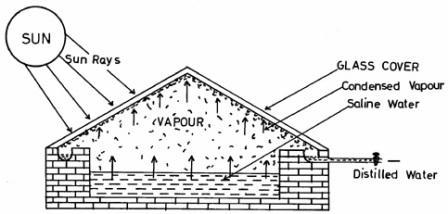Solar Stills
Solar Stills
Communities especially women, especially those living in saline water regions have a hard time collecting drinking water and purifying it for making it potable. Water Still purifies brackish water by utilising the sun rays - hence a simple, inexpensive and sustainable renewable energy technology.
Construction of a solar still
This technology is based on the simple evaporation-condensation principle by the virtue of which the sun evaporates the sea-water and then condenses it to culminate into pure rain water. Saline water is fed into the tank which is exposed to the sun. The black bottom of the tank absorbs solar energy and gets heated. The heat evaporates the tank water which condenses on the glass sheet and finally converts into drops of pure drinking water. This purified water collects in the channel running through a tap. Hence, you get clean hygienic drinking water by simply turning on the tap and storing this water for further usage. The average output of the still is 2 to 3 litres of drinking water per day per square metre of the area.

Source : Central Salt and Marine Chemicals Research Institute (CSMCRI), Gijubhai Badekar Marg, Bhavnagar- 364 002, Gujarat
Solar energy driven portable domestic Brackish Water Reverse Osmosis (BWRO) technology of BARC
This technology developed by Bhabha Atomic Research Centre (BARC) is based on solar photovoltaic (PV) system hence it is battery-less, off-grid/stand-alone. It has capacity of 10 litres/hr (lph) which can desalinate contaminated water of salinity 1000 - 3000 ppm (mg/lit) to provide drinking water of 50 - 300 ppm. The product water will be devoid of toxic elements, pathogens & turbidity too. In this technology, water purification/desalination takes place by a pressure driven, membrane based process called Reverse Osmosis. Electricity required for pressurization is generated with the help of solar PV system. The technology is best suited for remote/rural areas where electricity is not available or the voltage is not steady. It can be used in urban areas also. As it is portable, it will be of great help for people working in desert areas especially in the case of defence personnel.
For details contact Head, Technology Transfer & Collaboration Division, Bhabha Atomic Research Centre, Trombay, Mumbai - 400 085. Phone: +91-22-25593897 Fax: +91-22-25505151 / 25519613
Source : Bhabha Atomic Research Centre,Trombay, Mumbai
Last Modified : 3/2/2020
